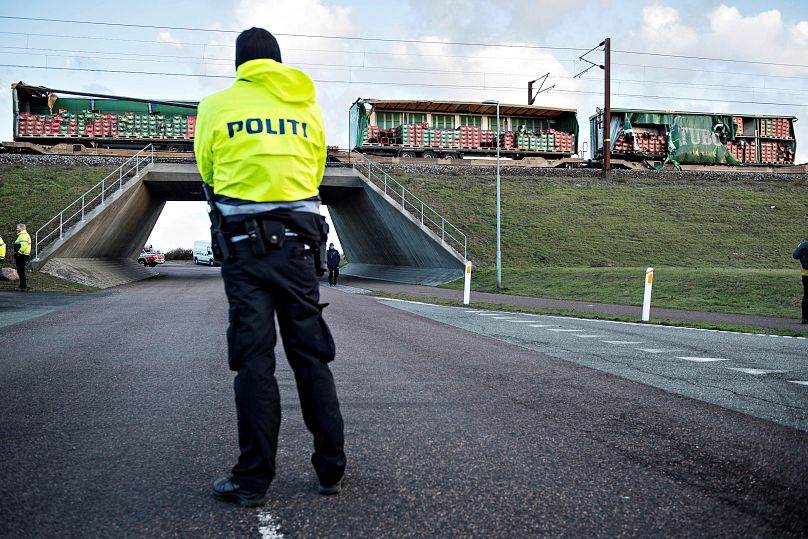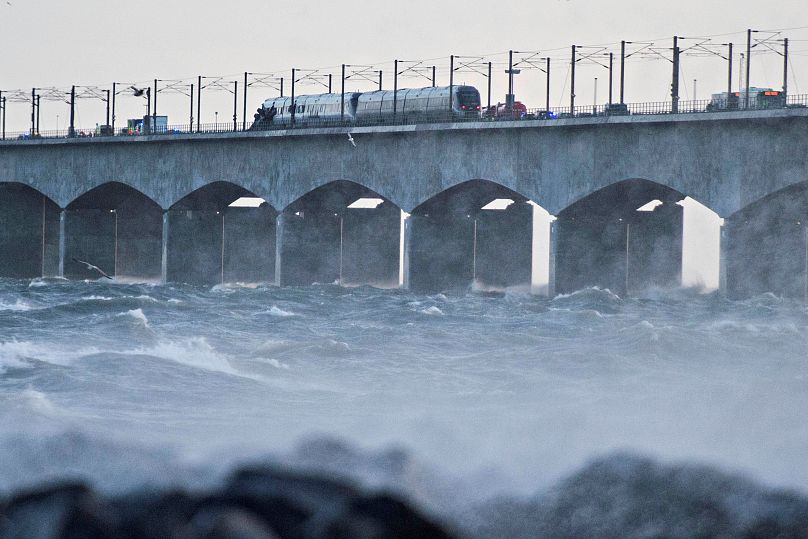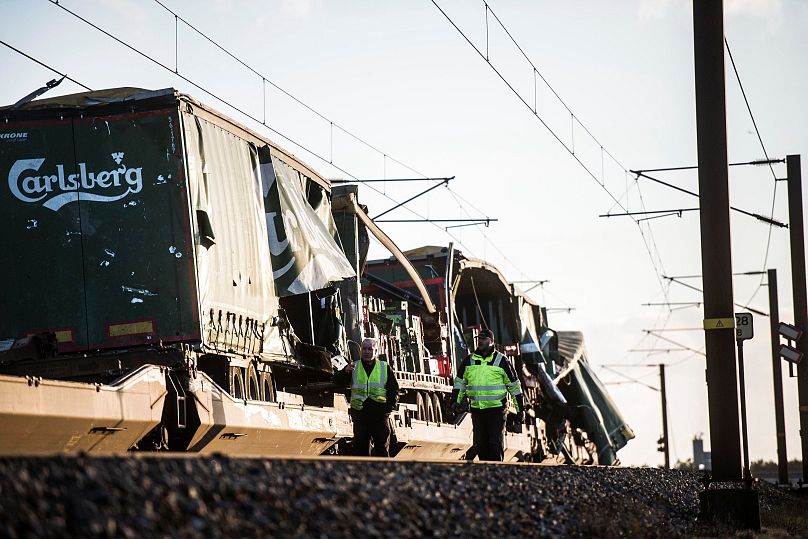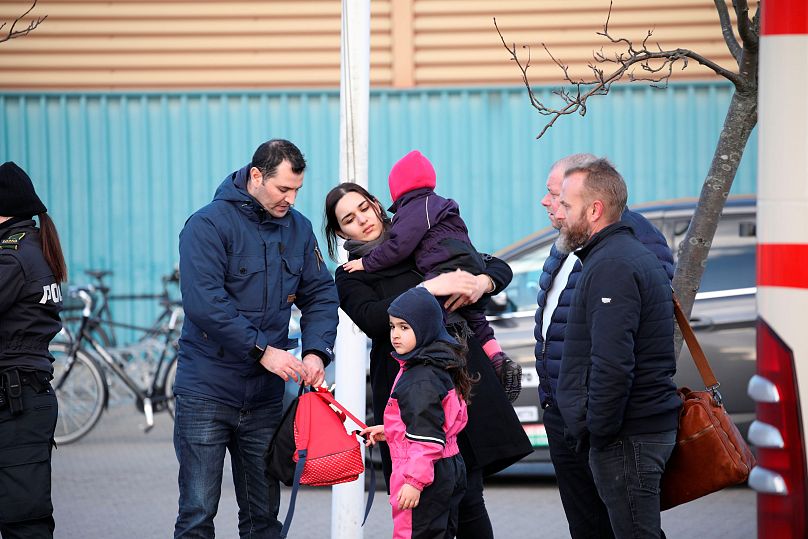At least eight people were killed in a train accident on a bridge in Denmark on Wednesday, police on the island of Fyn have said. Authorities added it's likely no foreign nationals are among the casualties.
At least eight people were killed and 16 injured when a passenger train hit a freight trailer on a bridge in Denmark, said police on the Island of Fyn.
Five women and three men were killed in the accident that took place around 7:35 am CET on Wednesday. Police are still working to identify all the victims but said it was very likely that no foreign nationals were among the casualties.
Forensics said all casualties were Danish citizens, none of whom were related to each other. Their relatives have been informed.
The bridge — also known as the Great Belt Bridge — links Fyn to the island of Sjaelland.
The train had 131 on board and was heading to Copenhagen when it hit the trailer that had blown off a wagon coming the other way.
The Danish Accident Investigation Board's initial probe into the incident showed a trailer had blown off a freight wagon onto the oncoming tracks, a spokesman said.
A severe storm in Denmark was making it difficult for emergency services to reach the train, which was halted on the bridge.
The 16 injured have been taken to a hospital in Odense with non-critical injuries.
The bridge reopened to vehicle traffic in both directions with a reduced speed of 50km/h due to winds. However, due to congestion near the crash site that police said was due to drivers slowing down to film on their phones, the road had to be closed again in the westbound direction.
Banedanmark, the government body responsible for the upkeep of the Danish railway, said in a tweet there would be no trains crossing the bridge for the rest of the day.
They hope to resume operations on Thursday and said preparations are in place to move the train and take it to an area where it can be investigated by authorities.
Palle Jensen, a journalist at Denmark's TV 2 was at the scene and told Euronews that a freight train probably caused the accident.
"It was loaded with empty bottles for the Carlsberg brewery and somehow one of the trailers fell off the train," he said.
"We can see an empty cargo bed in front of the train. That is what destroyed most of the freight trailers and caused the accident that cost six people their lives.
"The trailer fell off and the passenger train collided with the freight trailer, that's what we think happened."
'No collision between freight and passenger train'
Authorities are still investigating the incident.
"The investigation is underway. We still do not know the exact reasons, but we can confirm that some goods fell off a wagon off the freight train, and then the oncoming train hit those goods,"
Lars Bræmhøj, Chief Police Inspector for Fyn Police said at a press conference on Wednesday afternoon, adding there was significant damage to the train.
Bræmhøj, added that it was unknown at this time where the freight train had come from or where it had been loaded.
"One can see out there is a trailer that is overturned or blown by the freight train. If it has hit the train in front or in the side, we do not know," said deputy head of the Danish Accident Investigation Board, Bo Haaning.
A spokesperson for train operator DSB told Euronews that there wasn't a collision between a nearby freight train and the passenger train, but rather that something may have become detached from the cargo shipment and hit the passenger train, causing it to brake hard.
Adverse weather infringing on rescue operation
Gram said that weather conditions were making it difficult for emergency services to reach passengers but that authorities were doing the best they could to reach those injured.
"It is obvious that the infrastructure is vulnerable and the conditions are severe at Storebaelt (Great Belt Bridge) at the moment, but as I said passengers and the dead are the strategic focus for us."
DSB's CEO, Flemming Jensen, said that his company took the accident "very seriously" and that everyone was "deeply affected by both deaths and injuries."
"Our thoughts go to the relatives, and we do everything possible to assist the customers and their relatives."
The Danish brewery company, Carlsberg, has confirmed that a freight train carrying their merchandise was involved in the accident.
Kasper Elbjørn, director of International and Danish media told NBC:
"We know very little, but are of course deeply concerned about the accident. DB Cargo Scandinavia, the operator, who is responsible for shipping our goods, has unfortunately confirmed that a freight train carrying our goods was involved in the accident. We do not know any more at this point in time, but we are in close contact with the operator, and we will of course do everything we can to help with the investigation. Our deepest compassion with all involved."
In a press release, Danish Prime Minister, Lars Løkke Rasmussen, said:
“This morning’s tragic accident on the Great Belt Bridge which left several dead and wounded has shaken us all. Ordinary Danes on their way to work or on their way back from the Christmas holidays have had their lives shattered. This is deeply sad.
My thoughts are with the victims and their families. I’d like to thank the authorities for their great efforts in the past few hours.
At the same time I have been comforted by messages from colleagues who have followed the events from afar."
Police have set up an evacuation centre in Nyborg for the passengers from the train.
The police also called on everyone who has been on board the train to contact their relatives and state that they are okay and have asked the public to not slow down at the site of the accident or take any pictures.
The 18-kilometre long bridge across the Great Belt carries around 21,000 train passengers every day and more than 27,000 vehicles cross the bridge each day.
The bridge is part of the infrastructure that links Denmark and Sweden to Germany.
Witness accounts
Euronews spoke to Heidi Zumbusch, a train passenger who suffered no injuries. She said the train crew took "very good care" of the passengers.
In a Facebook post shared at 8:20 am CET, she reiterated that the train staff was "extremely competent" and that she was waiting out on the bridge to be rescued.
According to her post, Zumbusch was on her way to the airport at the time of the accident and said she wouldn't be taking the plane anymore.
Reactions
Swedish prime minister Stefan Löfven blamed the weather.
"Terrible train accident on the Great Belt Bridge in Denmark as a result of the storm Alfrida. Our thoughts are with the injured and with the families and relatives of the dead," he said in a tweet.
Danish EU Commissioner Margrethe Vestager and President of the EU Commission Jean-Claude Juncker also tweeted her condolences.















